Study on Wind Farm Flow Field Characteristics Based on Boundary Condition Optimization of Complex Mountain Numerical Simulation
Abstract
1. Introduction
2. Methodology
3. Case Analysis of Wind Farms in Complex Terrains
3.1. Introduction to the Wind Farm
3.2. On-Site Measurement and Wind Data Processing
3.3. Numerical Simulation
3.3.1. Geometric Model and Computational Domain
3.3.2. Mesh Division and Mesh Independence
3.3.3. Boundary Conditions and Operating Conditions
3.3.4. CFD Simulation Results Validation
4. Results and Discussion
4.1. Flow Field Characteristics under Different Wind Directions
4.1.1. Mean Wind Speed
4.1.2. Turbulence Intensity
4.2. Local Terrain Impact under the Same Wind Direction
4.2.1. Changes in Local Streamlines
4.2.2. Local Turbulence Intensity
5. Conclusions
- Terrain Modeling: Considering the impact of “man-made cliffs”, a transitional curve that restores the original terrain variations within the transition section is used. To avoid grid errors, a cylindrical fluid domain is established, and the range of the inlet and outlet areas is flexibly selected to achieve wind direction conversion. In terms of boundary conditions, the inlet wind speed is corrected by the acceleration ratio to obtain a flow field distribution that is closer to reality.
- Wind Measurement Data Analysis: The analysis of the wind measurement tower data shows a dominant wind direction concentrated in the W sector, accounting for 23.59% of occurrences, followed by the WSW and SSE sectors, with frequencies of 19.05% and 12.77%, respectively. Most wind speeds vary between 5 m/s and 10 m/s. Turbulence intensity mainly ranges from 0.1 to 0.3, generally indicating low to moderate turbulence intensity.
- Applicability of the New Method: The proposed method shows good applicability to complex terrain wind farms. Comparing numerical simulations with field-measured wind speed and direction, the wind speed error is within 6%, and the wind direction error is within 15°, indicating a certain degree of accuracy. Combining numerical simulations with measured data can recreate the actual flow field near the wind measurement tower, providing practical guidance for engineering.
- Flow Field Characteristics Comparison: Comparing the flow field characteristics under different wind directions reveals a significant terrain shielding effect on both wind speed distribution and turbulence intensity. The wind speed distribution and turbulence intensity are particularly evident under 120° and 150° wind directions, due to a ridge line in the terrain that is almost perpendicular to the incoming wind. When the incoming wind reaches the ridge or hilltop, it forms a low-speed wake region behind, where the wind speed decreases, the turbulence intensity increases, and the flow field becomes unstable.
- Terrain Impact on Flow Field: To observe the terrain impact under the same wind direction, a ridge section almost perpendicular to the incoming wind and unaffected by other terrain features is selected. Changes in the lateral wind profile and turbulence intensity at the measurement points are observed. The results show that the flow field in complex terrains is significantly affected by terrain variations and the cumulative impact of continuous terrain changes, leading to inconsistent patterns. Overall, high-acceleration flow field regions are less affected by turbulence and eventually achieve higher wind speeds.
Author Contributions
Funding
Data Availability Statement
Conflicts of Interest
Nomenclature and Abbreviations
| Adjusted terrain elevation (m) | |
| Original terrain coordinate point elevation (m) | |
| Radius of the actual terrain to be preserved (m) | |
| Length of the transition section (m) | |
| Average wind speed at a certain height z at the meteorological mast (m/s) | |
| Wind speed 10 m above the ground obtained from the analysis of wind measurement data (m/s) | |
| Ground roughness | |
| Height (m) | |
| Average wind speed at a certain height above the ground in the wind measurement data (m/s) | |
| Average wind speed at the same height as in the first numerical simulation (m/s) | |
| Wind acceleration ratio | |
| The inlet velocity of the second numerical simulation (m/s) | |
| Numerical simulation of turbulence intensity | |
| Wind speed value at height z in the numerical simulation (m/s) | |
| Turbulence kinetic energy (m2/s2) | |
| Physical height of the roughness | |
| Roughness constant | |
| Roughness length | |
| Turbulence intensity at height z | |
| Turbulence dissipation rate (m2/s3) | |
| Coefficient for the turbulent viscosity | |
| Turbulence integral scale | |
| Gradient height (m) | |
| Tower wind speed of numerical simulation (m/s) | |
| Tower wind speed of wind measurement tower (m/s) | |
| Wind directions of wind numerical simulation (°) | |
| Wind directions of wind measurement tower (°) | |
| CFD | Computational fluid dynamics |
| RANS | Reynolds-averaged Navier–Stokes |
| LES | Large eddy simulation |
| NWP | Numerical weather prediction |
| BTS | Boundary transition slope |
| BOI | Body of Influence |
| UDF | User defined function |
References
- Molla, S.; Farrok, O.; Alam, M.J. Electrical energy and the environment: Prospects and upcoming challenges of the World’s top leading countries. Renew. Sustain. Energy Rev. 2024, 191, 114177. [Google Scholar] [CrossRef]
- Liu, J.; Song, D.; Li, Q.; Yang, J.; Hu, Y.; Fang, F.; Hoon Joo, Y. Life cycle cost modelling and economic analysis of wind power: A state of art review. Energy Convers. Manag. 2023, 277, 116628. [Google Scholar] [CrossRef]
- Mark Hutchinson, Feng Zhao. GWEC|Global Wind Report 2023. Available online: https://gwec.net/globalwindreport2023/ (accessed on 24 June 2024).
- Astolfi, D.; Castellani, F.; Terzi, L. A Study of Wind Turbine Wakes in Complex Terrain Through RANS Simulation and SCADA Data. J. Sol. Energy Eng. 2018, 140, 031001. [Google Scholar] [CrossRef]
- Chen, F.; Wang, W.; Gu, Z.; Zhu, Y.; Li, Y.; Shu, Z. Investigation of hilly terrain wind characteristics considering the interference effect. J. Wind Eng. Ind. Aerodyn. 2023, 241, 105543. [Google Scholar] [CrossRef]
- Berg, J.; Mann, J.; Bechmann, A.; Courtney, M.S.; Jorgensen, H.E. The Bolund Experiment, Part I: Flow Over a Steep, Three-Dimensional Hill. Bound.-Layer Meteorol. 2011, 141, 219–243. [Google Scholar] [CrossRef]
- Kim, D.; Kim, T.; Oh, G.; Huh, J.; Ko, K. A comparison of ground-based LiDAR and met mast wind measurements for wind resource assessment over various terrain conditions. J. Wind Eng. Ind. Aerodyn. 2016, 158, 109–121. [Google Scholar] [CrossRef]
- Assireu, A.T.; Pimenta, F.M.; de Freitas, R.M.; Saavedra, O.R.; Neto, F.L.; Júnior, A.R.T.; Oliveira, C.B.; Lopes, D.C.; de Lima, S.L.; Veras, R.B.J.E. EOSOLAR Project: Assessment of wind resources of a coastal equatorial region of Brazil—Overview and preliminary results. Energies 2022, 15, 2319. [Google Scholar] [CrossRef]
- Shen, G.H.; Yao, J.F.; Lou, W.J.; Chen, Y.; Guo, Y.; Xing, Y.L. An Experimental Investigation of Streamwise and Vertical Wind Fields on a Typical Three-Dimensional Hill. Appl. Sci. 2020, 10, 1463. [Google Scholar] [CrossRef]
- Zheng, K.; Tian, W.; Qin, J.; Hu, H. An experimental study on the turbulent flow over two-dimensional plateaus. In Proceedings of the 2018 Wind Energy Symposium, Kissimmee, FL, USA, 8–12 January 2018. [Google Scholar]
- Radünz, W.C.; Mattuella, J.M.L.; Petry, A.P. Wind resource mapping and energy estimation in complex terrain: A framework based on field observations and computational fluid dynamics. Renew. Energy 2020, 152, 494–515. [Google Scholar] [CrossRef]
- Castro, F.A.; Palma, J.; Lopes, A.S. Simulation of the Askervein flow.: Part 1: Reynolds averaged Navier-Stokes equations (k-ε turbulence model). Bound.-Layer Meteorol. 2003, 107, 501–530. [Google Scholar] [CrossRef]
- Paiva, L.M.S.; Bodstein, G.C.R.; Menezes, W.F. Numerical simulation of atmospheric boundary layer flow over isolated and vegetated hills using RAMS. J. Wind Eng. Ind. Aerodyn. 2009, 97, 439–454. [Google Scholar] [CrossRef]
- Dhunny, A.Z.; Lollchund, M.R.; Rughooputh, S. Wind energy evaluation for a highly complex terrain using Computational Fluid Dynamics (CFD). Renew. Energy 2017, 101, 1–9. [Google Scholar] [CrossRef]
- Han, Y.; Stoellinger, M.; Naughton, J. Large eddy simulation for atmospheric boundary layer flow over flat and complex terrains. In Proceedings of the Conference on Science of Making Torque from Wind (TORQUE), Munich, Germany, 7 October 2016. [Google Scholar]
- Li, T.; Liu, Z.; Wang, H.; Bian, W.; Yang, Q. Large eddy simulation for the effects of ground roughness and atmospheric stratification on the wake characteristics of wind turbines mounted on complex terrains. Energy Convers. Manag. 2022, 268, 115977. [Google Scholar] [CrossRef]
- Diebold, M.; Higgins, C.; Fang, J.N.; Bechmann, A.; Parlange, M.B. Flow over Hills: A Large-Eddy Simulation of the Bolund Case. Bound. Layer Meteorol. 2013, 148, 177–194. [Google Scholar] [CrossRef]
- Cheng, X.; Yan, B.W.; Zhou, X.H.; Yang, Q.S.; Huang, G.Q.; Su, Y.W.; Yang, W.; Jiang, Y. Wind resource assessment at mountainous wind farm: Fusion of RANS and vertical multi-point on-site measured wind field data. Appl. Energy 2024, 363, 123116. [Google Scholar] [CrossRef]
- Rodrigues, C.V.; Palma, J.; Rodrigues, A.H. Atmospheric Flow over a Mountainous Region by a One-Way Coupled Approach Based on Reynolds-Averaged Turbulence Modelling. Bound. Layer Meteorol. 2016, 159, 407–437. [Google Scholar] [CrossRef]
- Durán, P.; Meissner, C.; Casso, P. A new meso-microscale coupled modelling framework for wind resource assessment: A validation study. Renew. Energy 2020, 160, 538–554. [Google Scholar] [CrossRef]
- Song, M.X.; Chen, K.; He, Z.Y.; Zhang, X. Wind resource assessment on complex terrain based on observations of a single anemometer. J. Wind Eng. Ind. Aerodyn. 2014, 125, 22–29. [Google Scholar] [CrossRef]
- Yan, B.W.; Li, Q.S. Coupled on-site measurement/CFD based approach for high-resolution wind resource assessment over complex terrains. Energy Convers. Manag. 2016, 117, 351–366. [Google Scholar] [CrossRef]
- Tang, X.Y.; Zhao, S.M.A.; Fan, B.; Peinke, J.; Stoevesandt, B. Micro-scale wind resource assessment in complex terrain based on CFD coupled measurement from multiple masts. Appl. Energy 2019, 238, 806–815. [Google Scholar] [CrossRef]
- Maurizi, A.; Palma, J.M.L.M.; Castro, F.A. Numerical simulation of the atmospheric flow in a mountainous region of the North of Portugal. J. Wind Eng. Ind. Aerodyn. 1998, 74, 219–228. [Google Scholar] [CrossRef]
- Hu, P.; Li, Y.L.; Huang, G.Q.; Kang, R.; Liao, H.L. The appropriate shape of the boundary transition section for a mountain-gorge terrain model in a wind tunnel test. Wind Struct. 2015, 20, 15–36. [Google Scholar] [CrossRef]
- Ren, H.H.; Laima, S.J.; Chen, W.L.; Zhamg, B.; Guo, A.X.; Li, H. Numerical simulation and prediction of spatial wind field under complex terrain. J. Wind Eng. Ind. Aerodyn. 2018, 180, 49–65. [Google Scholar] [CrossRef]
- Huang, G.Q.; Cheng, X.; Peng, L.L.; Li, M.S. Aerodynamic shape of transition curve for truncated mountainous terrain model in wind field simulation. J. Wind Eng. Ind. Aerodyn. 2018, 178, 80–90. [Google Scholar] [CrossRef]
- Liu, Z.Q.; Ishihara, T.; He, X.H.; Niu, H.W. LES study on the turbulent flow fields over complex terrain covered by vegetation canopy. J. Wind Eng. Ind. Aerodyn. 2016, 155, 60–73. [Google Scholar] [CrossRef]
- Castellani, F.; Astolfi, D.; Burlando, M.; Terzi, L. Numerical modelling for wind farm operational assessment in complex terrain. J. Wind Eng. Ind. Aerodyn. 2015, 147, 320–329. [Google Scholar] [CrossRef]
- GB50009; Load Code for the Design of Building Structures. Urban-Rural Construction of the People’s Republic of China: Beijing, China, 2012.
- Hu, W.C.; Yang, Q.S.; Chen, H.P.; Yuan, Z.T.; Li, C.; Shao, S.; Zhang, J. Wind field characteristics over hilly and complex terrain in turbulent boundary layers. Energy 2021, 224, 120070. [Google Scholar] [CrossRef]
- Yamaguchi, A.; Ishihara, T.; Fujino, Y. Numerical modeling of local wind focusing on computational domain setting and boundary treatments. In Proceedings of the Fourth International Symposium on Computational Wind Engineering, Yokohama, Japan, 16–19 July 2006. [Google Scholar]
- Blocken, B.; Stathopoulos, T.; Carmeliet, J. CFD simulation of the atmospheric boundary layer: Wall function problems. Atmos. Environ. 2007, 41, 238–252. [Google Scholar] [CrossRef]
- He, J.W.; Zhang, H.F.; Zhou, L. Numerical Simulation of Wind Characteristics in Complex Mountains with Focus on Terrain Boundary Transition Curve. Atmosphere 2023, 14, 230. [Google Scholar] [CrossRef]
- AIJ. RLB Recommendations for Loads on Buildings; Architectural Institute of Japan: Tokyo, Japan, 2004; pp. 611–613. [Google Scholar]
- Abdi, D.S.; Bitsuamlak, G.T. Wind flow simulations on idealized and real complex terrain using various turbulence models. Adv. Eng. Softw. 2014, 75, 30–41. [Google Scholar] [CrossRef]
- Blazek, J. Computational Fluid Dynamics: Principles and Applications; Butterworth-Heinemann: Oxford, UK, 2015. [Google Scholar]
- Blocken, B.; van der Hout, A.; Dekker, J.; Weiler, O. CFD simulation of wind flow over natural complex terrain: Case study with validation by field measurements for Ria de Ferrol, Galicia, Spain. J. Wind Eng. Ind. Aerodyn. 2015, 147, 43–57. [Google Scholar] [CrossRef]
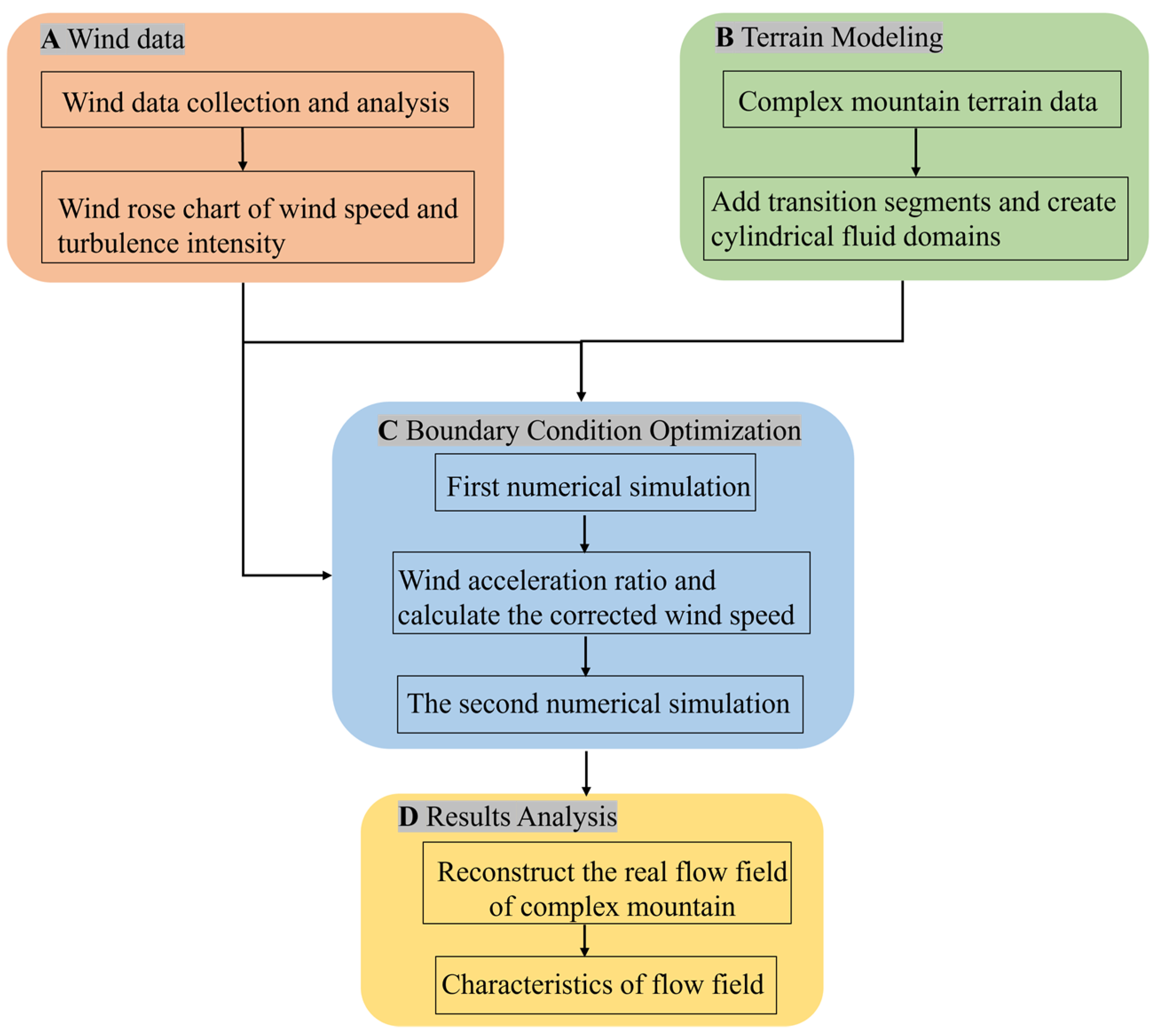

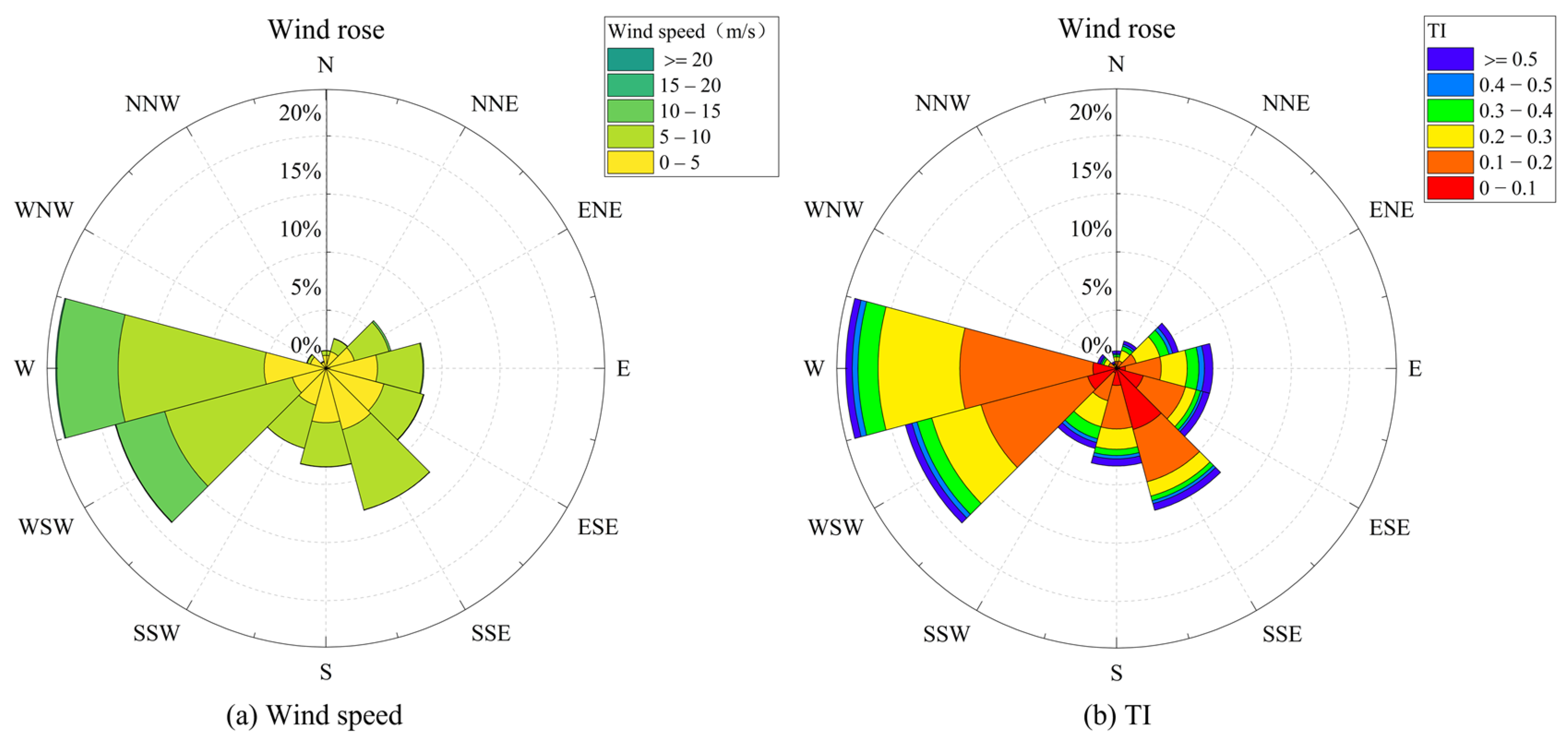

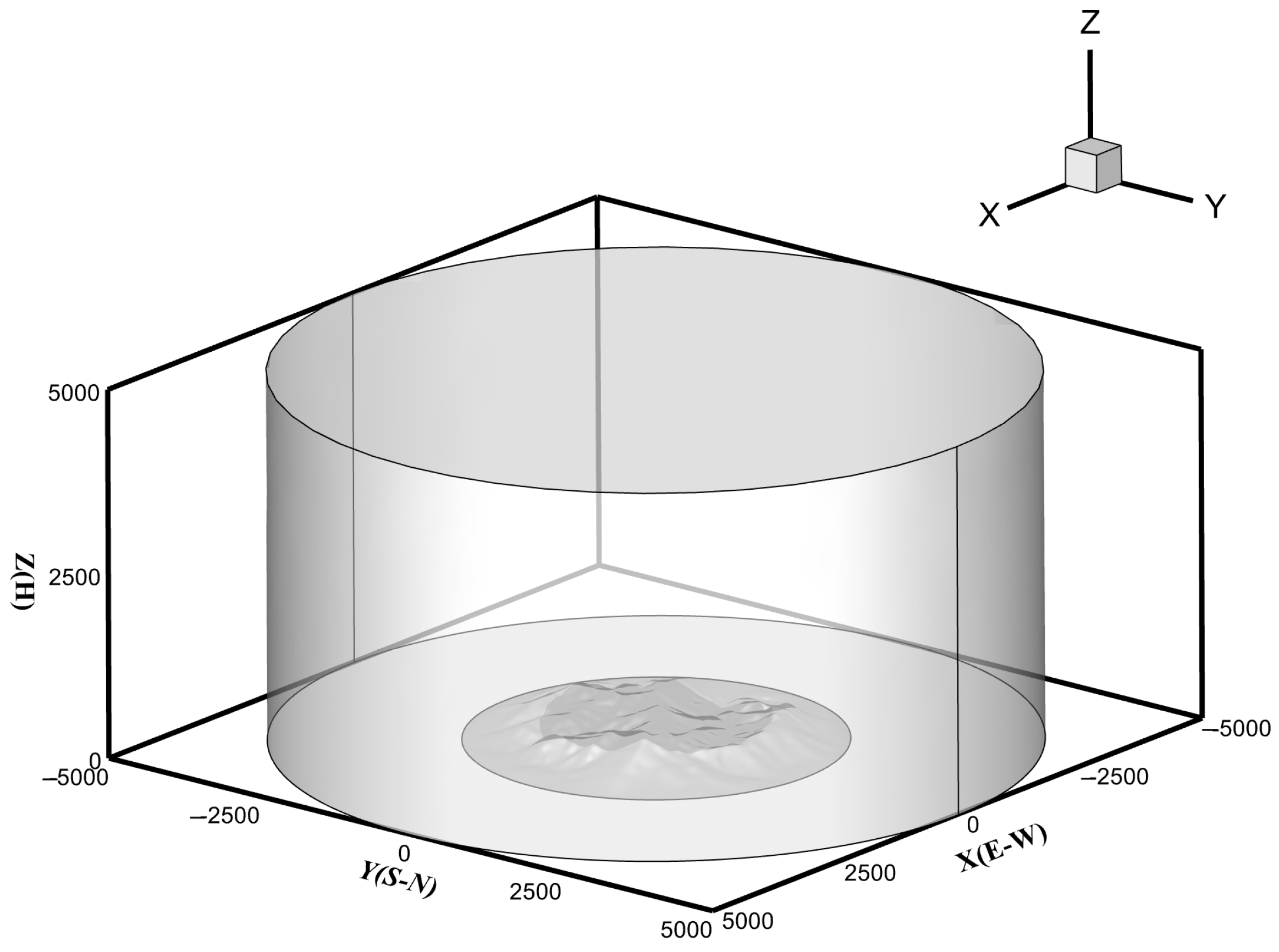

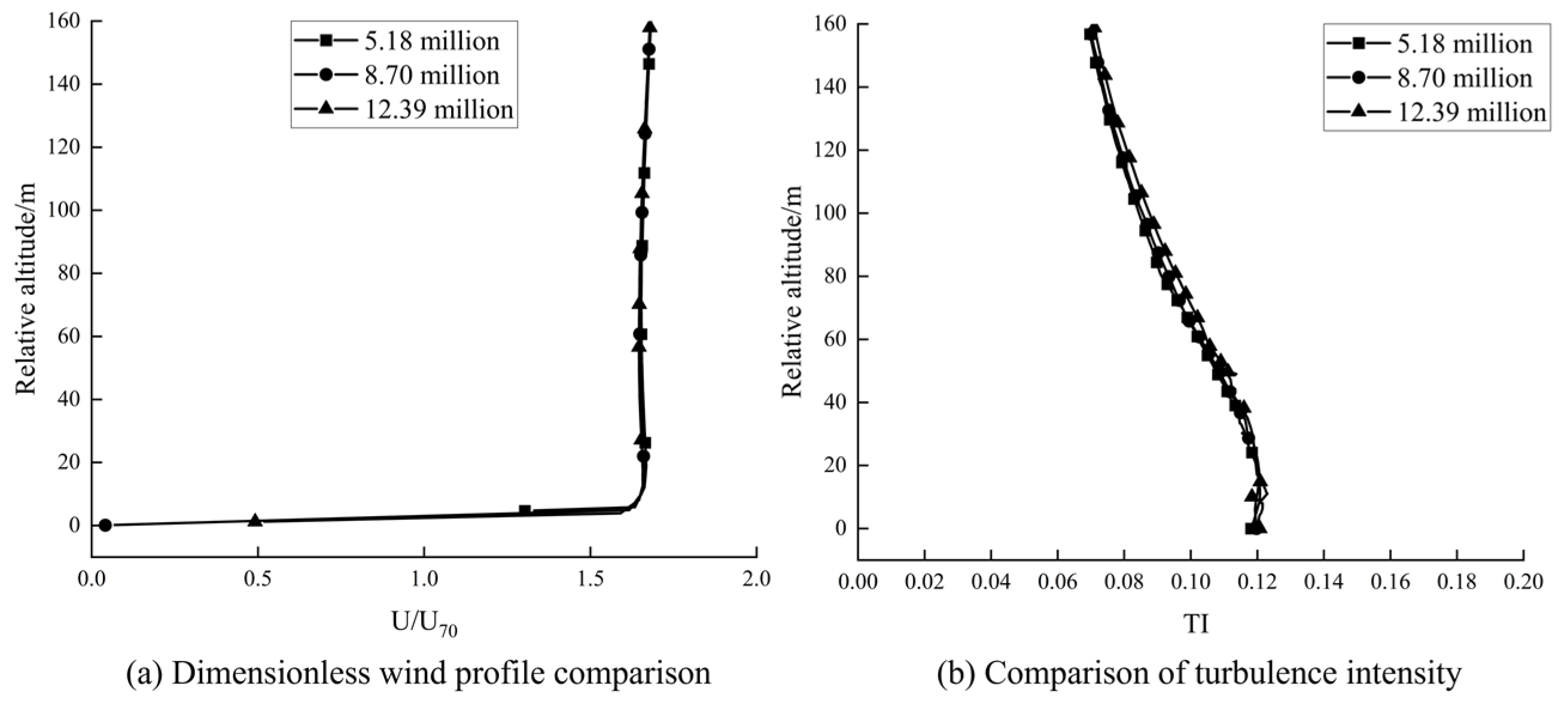
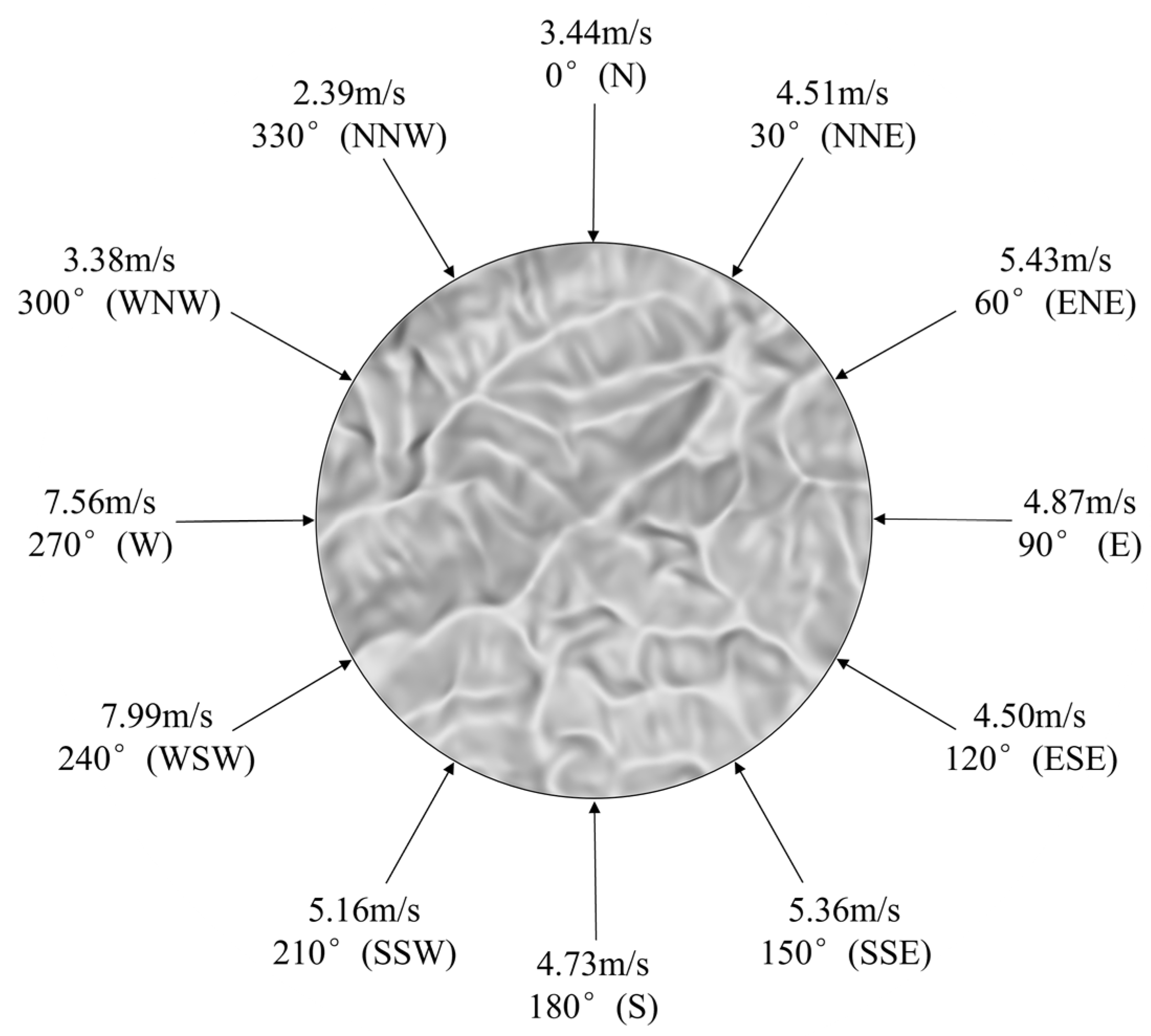

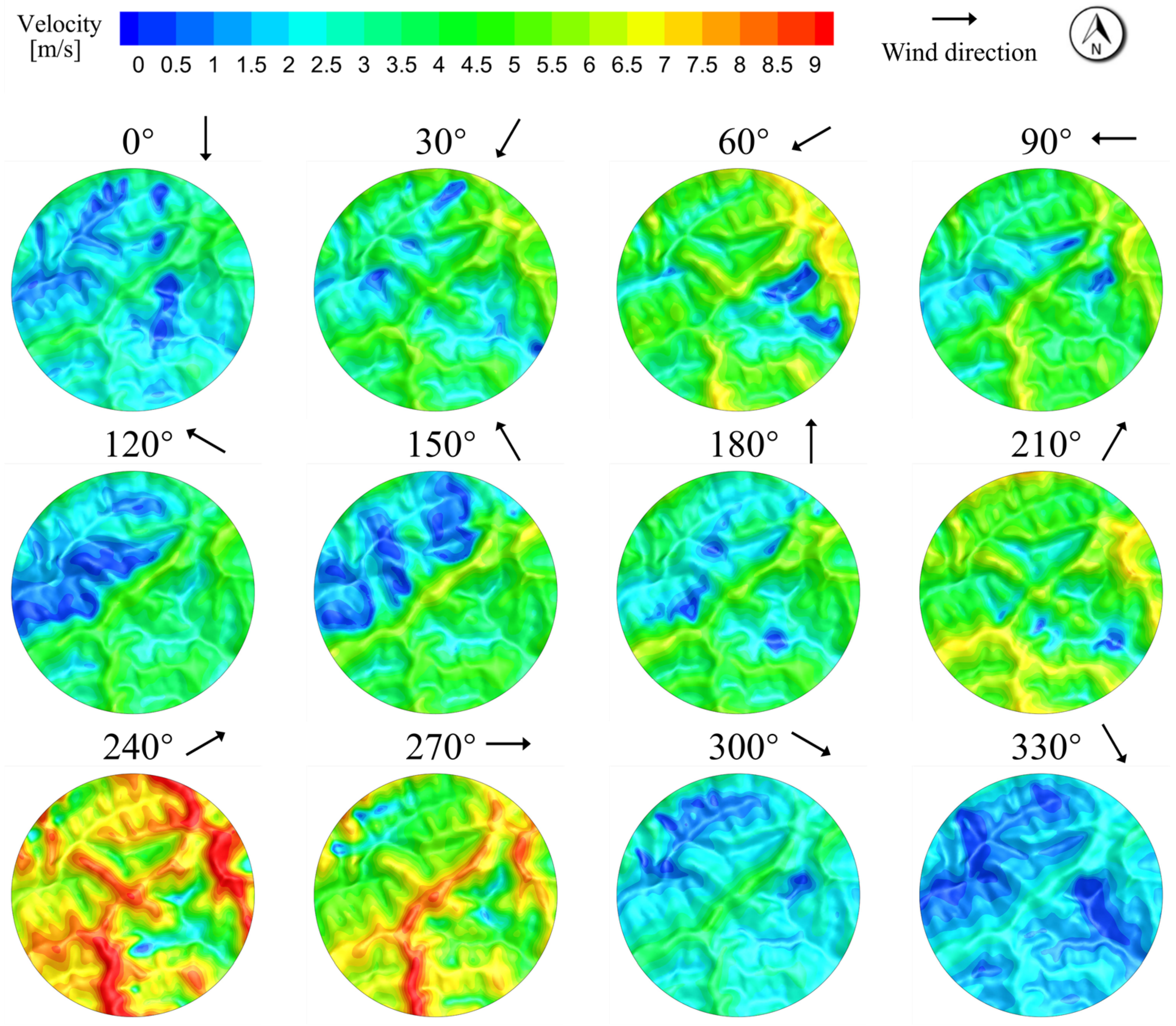
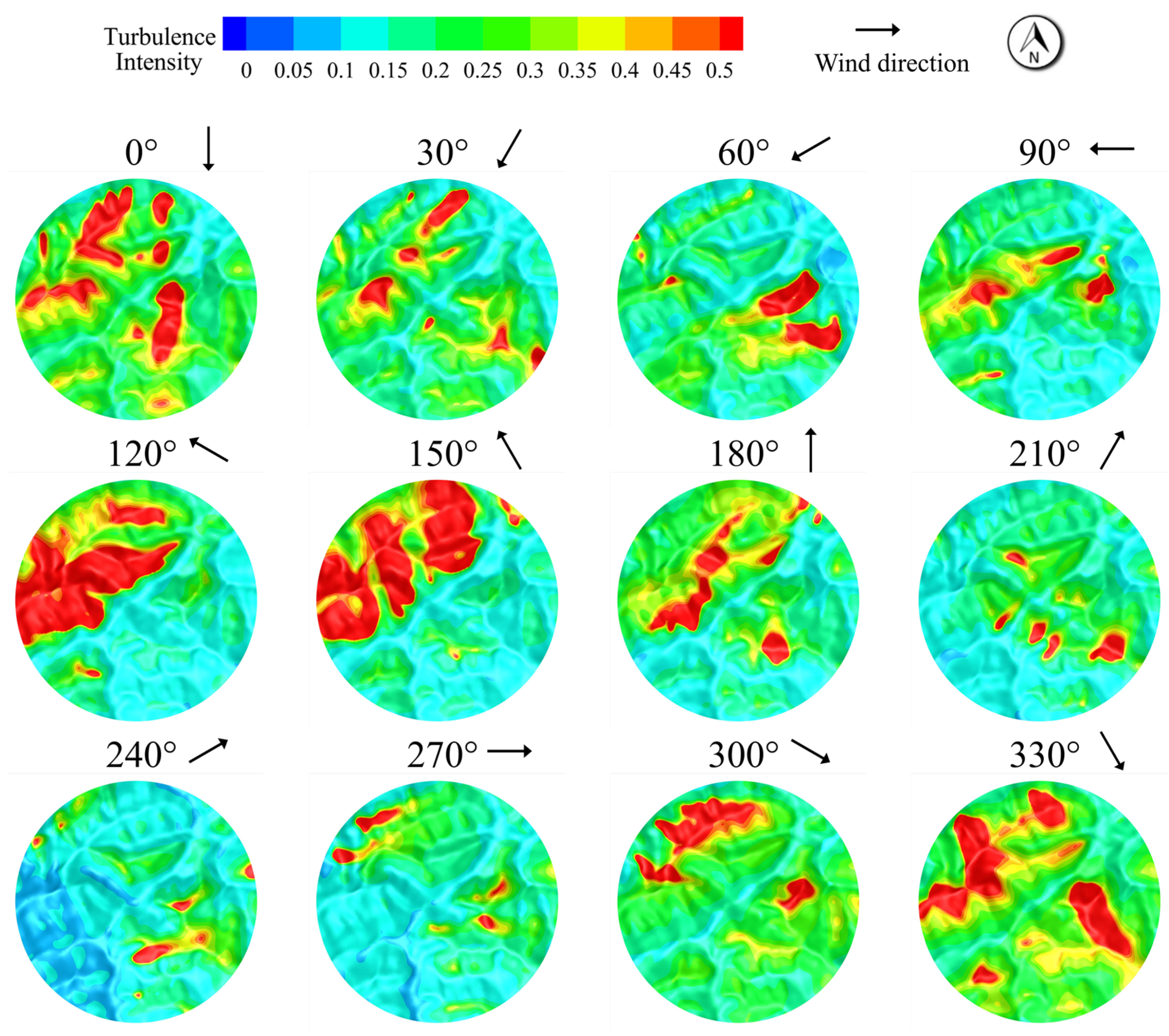

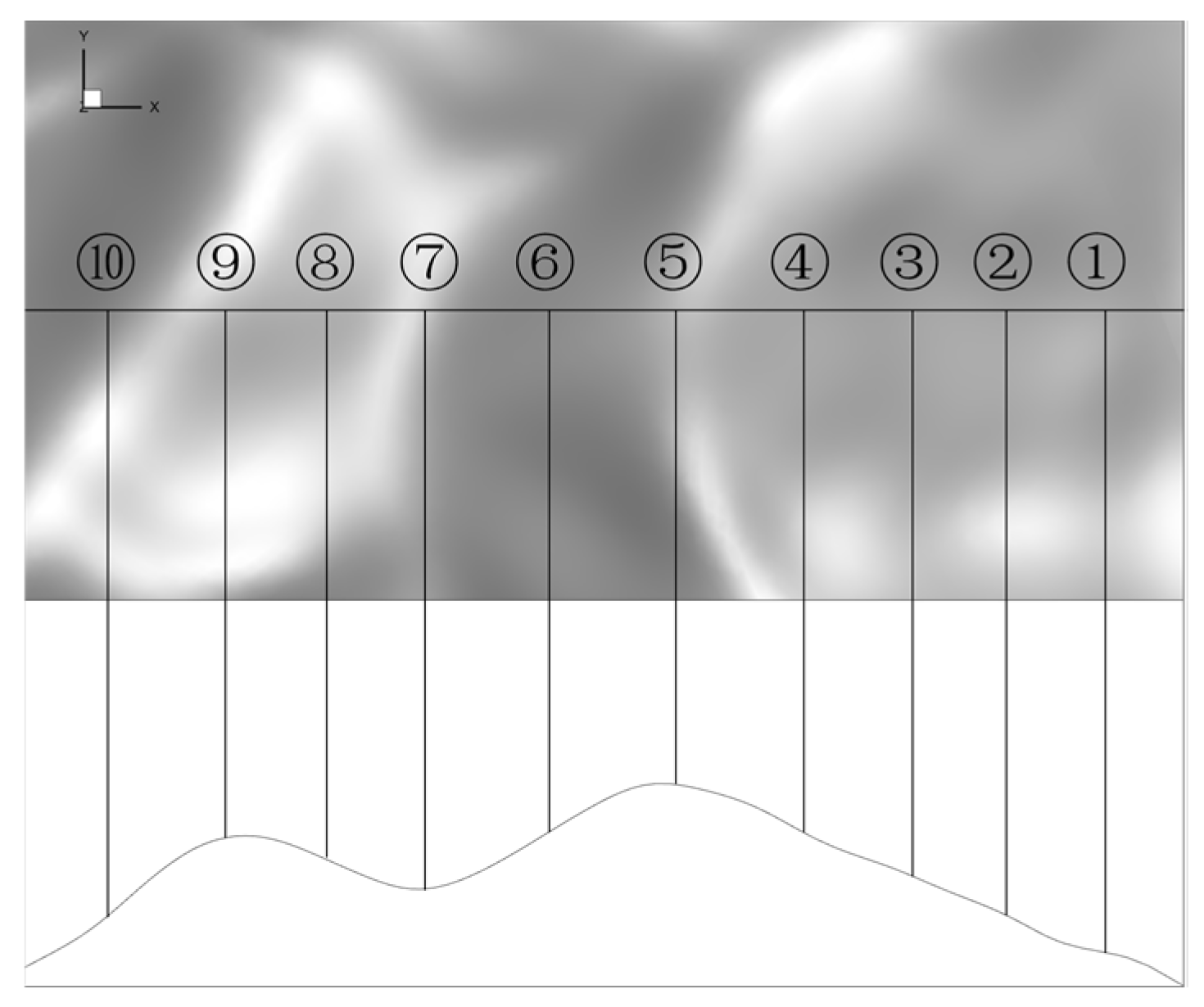
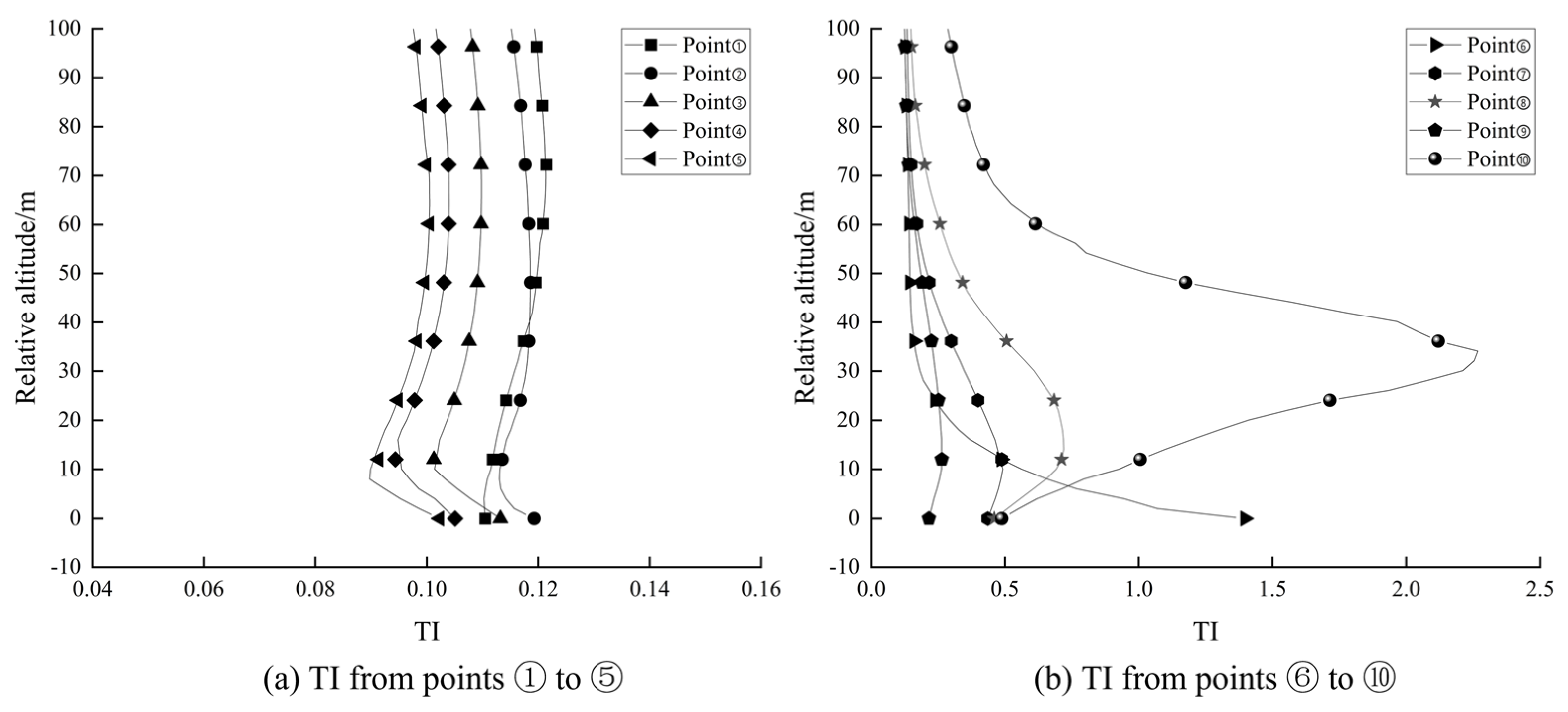
| Wind Field Type | Description | Ground Roughness Index α | (m) |
|---|---|---|---|
| A | Offshore sea and islands, coasts, lakeshore, and desert areas | 0.12 | 300 |
| B | Fields, villages, jungles, hills, and towns with sparse houses | 0.15 | 350 |
| C | An urban area with a dense cluster of buildings | 0.22 | 450 |
| D | An urban area consisting of a dense group of buildings with taller buildings | 0.30 | 550 |
Disclaimer/Publisher’s Note: The statements, opinions and data contained in all publications are solely those of the individual author(s) and contributor(s) and not of MDPI and/or the editor(s). MDPI and/or the editor(s) disclaim responsibility for any injury to people or property resulting from any ideas, methods, instructions or products referred to in the content. |
© 2024 by the authors. Licensee MDPI, Basel, Switzerland. This article is an open access article distributed under the terms and conditions of the Creative Commons Attribution (CC BY) license (https://creativecommons.org/licenses/by/4.0/).
Share and Cite
Wang, X.; Hu, J.; Deng, K.; Zhang, M.; Shen, S.; Shen, Y.; Chen, S.; Pan, W.; Wen, R.; Kang, W.; et al. Study on Wind Farm Flow Field Characteristics Based on Boundary Condition Optimization of Complex Mountain Numerical Simulation. Processes 2024, 12, 1885. https://doi.org/10.3390/pr12091885
Wang X, Hu J, Deng K, Zhang M, Shen S, Shen Y, Chen S, Pan W, Wen R, Kang W, et al. Study on Wind Farm Flow Field Characteristics Based on Boundary Condition Optimization of Complex Mountain Numerical Simulation. Processes. 2024; 12(9):1885. https://doi.org/10.3390/pr12091885
Chicago/Turabian StyleWang, Xiuru, Jianliang Hu, Kai Deng, Mingjie Zhang, Shizhao Shen, Yunshan Shen, Sheng Chen, Weijie Pan, Ruifeng Wen, Weiwei Kang, and et al. 2024. "Study on Wind Farm Flow Field Characteristics Based on Boundary Condition Optimization of Complex Mountain Numerical Simulation" Processes 12, no. 9: 1885. https://doi.org/10.3390/pr12091885
APA StyleWang, X., Hu, J., Deng, K., Zhang, M., Shen, S., Shen, Y., Chen, S., Pan, W., Wen, R., Kang, W., Pan, Z., & Xu, Z. (2024). Study on Wind Farm Flow Field Characteristics Based on Boundary Condition Optimization of Complex Mountain Numerical Simulation. Processes, 12(9), 1885. https://doi.org/10.3390/pr12091885






